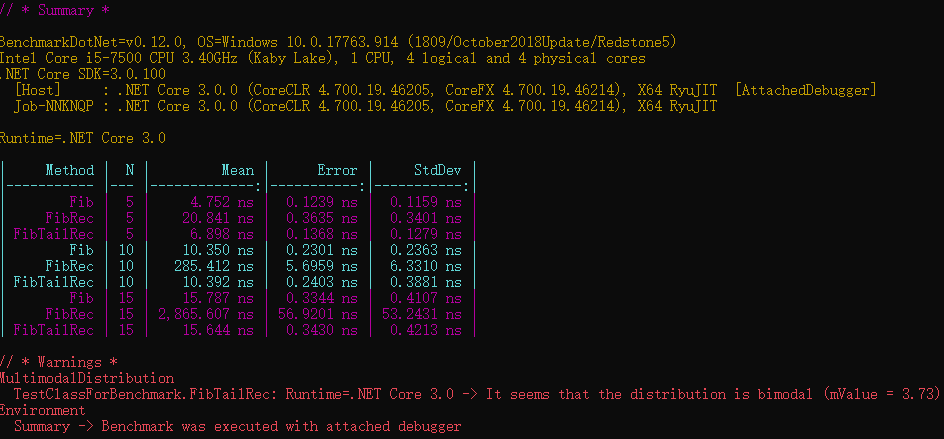生活中,如果1+2+3+4.....+100,大家基本上都会用等差数列计算,如果有人从1开始加,不是傻就是白X,那么程序中呢,是不是也是这样。今天无意中看到了尾递归,以前也写过,但是不知道这个专业名词,今天写一下对比下性能问题。
今天主要是看到了尾递归,所以联想到了这些,写下这篇文章,其中也把Benchmark (Nuget上的BenchmarkDotNet)的基准测试用了下,感觉比较好用,赞。Benchmark 需要在release下运行。
原则上所有的递归操作,都可以写成循环操作。尾递归是指,在函数返回的时候,调用自身本身,并且return语句不能包含表达式。这样编译器或者解释器就可以把尾递归做优化,试运行速度更快。
测试类
public class TestClass { ////// for循环 /// /// /// /// public int TestFor(int n) { int s = 1; for (int i = 2; i < n + 1; i++) { s = s + i; } return s; } /// /// 等差数列 /// /// /// /// public int TestForG(int n) { int s = (1 + n) * n / 2; return s; } /// /// 递归 /// /// /// /// public int TestRec(int n) { if (n == 1) return 1; return n + TestRec(n - 1); } /// /// 尾递归 /// /// /// /// public int TestTail(int n) { return TestTail(1, n); } public int TestTail(int sum, int n) { if (n == 1) return sum; sum = sum + n; return TestTail(sum, n - 1); } }
基准测试
[SimpleJob(RuntimeMoniker.NetCoreApp30)] [RPlotExporter] public class TestClassForBenchmark { private readonly TestClass testClass = new TestClass(); [Params(100,500,1000,5000)] public int N; [Benchmark] public void TestFor() { testClass.TestFor(N); } [Benchmark] public void TestForG() { testClass.TestForG(N); } [Benchmark] public void TestRec() { testClass.TestRec(N); } [Benchmark] public void TestTail() { testClass.TestTail(N); } }
Main程序调用
BenchmarkRunner.Run();
结果
用Benchmark的基准测试发现,运行时间:等差 < for < 尾递归(接近for) < 递归,for的运行速度比递归快,但是递归结构比较清晰,容易理解。
发现TestForG有点问题,接下来自己简单测试
实际用Stopwatch测试
TestClass testClass = new TestClass(); Stopwatch stopSwitch = new Stopwatch(); int n = 5000; stopSwitch.Start(); int sum = testClass.TestFor(n); stopSwitch.Stop(); Console.WriteLine($"结果:{sum},TestFor时间:{stopSwitch.ElapsedTicks}"); stopSwitch.Start(); sum = testClass.TestForG(n); stopSwitch.Stop(); Console.WriteLine($"结果:{sum},TestForG时间:{stopSwitch.ElapsedTicks}"); stopSwitch.Restart(); sum = testClass.TestRec(n); stopSwitch.Stop(); Console.WriteLine($"结果:{sum},TestRec时间:{stopSwitch.ElapsedTicks}"); stopSwitch.Restart(); sum = testClass.TestTail(n); stopSwitch.Stop(); Console.WriteLine($"结果:{sum},TestTail时间:{stopSwitch.ElapsedTicks}");
Stopwatch测试结果
1. 10次 结果:55,TestFor时间:2024 结果:55,TestForG时间:3799 结果:55,TestRec时间:1603 结果:55,TestTail时间:2371 2. 100 结果:5050,TestFor时间:1704 结果:5050,TestForG时间:2708 结果:5050,TestRec时间:1069 结果:5050,TestTail时间:1401 3. 500 结果:125250,TestFor时间:1794 结果:125250,TestForG时间:3096 结果:125250,TestRec时间:9398 结果:125250,TestTail时间:2332 4. 1000 结果:500500,TestFor时间:2080 结果:500500,TestForG时间:4147 结果:500500,TestRec时间:2003 结果:500500,TestTail时间:2540 5. 5000 结果:12502500,TestFor时间:1428 结果:12502500,TestForG时间:3982 结果:12502500,TestRec时间:6815 结果:12502500,TestTail时间:2799
结论
1. for的运行速度比递归快,但是递归结构比较清晰,容易理解。
2. 等差计算不一定比for循环快
斐波那契数列对比
////// 循环实现 counter:运行次数 /// public long Fib(int n, ref int counter) { if (n < 1) return 0; long a = 1, b = 1; long temp; for (int i = 3; i <= n; i++) { counter++; temp = a; a = b; b = temp + b; } return b; } /// /// 递归实现 /// public long FibRec(int n, ref int counter) { counter++; if (n < 1) return 0; if (n < 3) return 1; return FibRec(n - 1, ref counter) + FibRec(n - 2, ref counter); } /// /// 尾递归实现 /// public long FibTailRec(int n, ref int counter) { if (n < 1) return 0; if (n < 3) return 1; return FibRec(1, 1, n, ref counter); } public long FibRec(long last, long prev, int n, ref int counter) { counter++; long temp = last + prev; if (n == 3) return temp; last = prev; prev = temp; return FibRec(last, prev, n - 1, ref counter); }
效果
counter是运行的次数,斐波那契数列直接用递归,n=100都直接堆栈溢出。递归用的好了,思路清晰,用的不好的话,数据稍微大点就是深深的坑。用递归尽量优化为尾递归,也就是返回的时候调用自身,不要有表达式。

